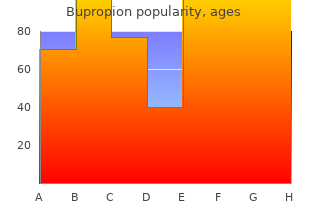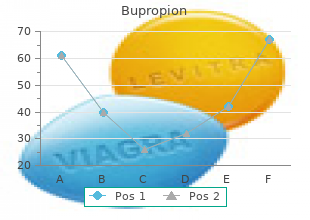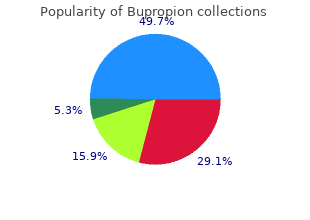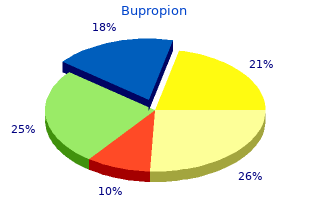Bupropion
"Purchase 150mg bupropion with amex, mood disorder nos dsm iv code".
By: N. Jensgar, M.A., M.D., M.P.H.
Deputy Director, TCU and UNTHSC School of Medicine
We to depression residual symptoms treatment discount bupropion 150 mg visa talk to depression treatment plan order bupropion from india a trained professional and talk more; we feel more comfortable identify problems we would normally with each other anxiety 8 year old buy online bupropion. But, for me, the voices of Will�s Stor y children, caregivers, and teachers are There are also benefts from the care the most-compelling evidence for the giver education sessions built into efectiveness of this intervention. I wouldn�t terrorized �George,� an elementary change anything because the group school student. Before the from school with my cousin when I group, I hardly talked in class, but heard somebody screaming. When I was running I thought base needed for early intervention in the men were following us. I thought the treatment of trauma, and how to they could look for us at school and expand and enhance school-based hurt us. Every day I tried a diferent these ideas together by providing an way to go to and from school. I was able to do public and private K-12 schools across better at school because I had better the United States. Kids can a must-read for the school counselor, improve their grades, like I did, and school psychologist, or school social get along with their teachers. How series of group sessions designed to run ever, a substantial minority continue to �bell to bell� during one class period. Trauma exposure can tion with Los Angeles Unifed School lead to a variety of problems, including District school-based social workers, alterations in mood and behavior and ensuring that it is feasible and acceptable loss of social and academic functioning in the school environment. This second edition to sists at least one month following trauma the original 2003 manual retains all of the exposure and includes the following core content of the program and updates four kinds of symptoms, according to it with lessons learned through training the Diagnostic and Statistical Manual of and implementation. Though focused about child abuse and domestic primarily on students with moderate violence is also increasing. However, such students can infuence later adult mental and may require concurrent individ physical health (Felitti et al. Training in the use of this interventions for at-risk students, and manual is strongly encouraged. For tertiary interventions for those in more information, including detailed need of services (see Reinbergs and implementation materials, see Following training, secondary or tertiary intervention, implementation support is also very depending on the level of need of important, including coaching and the students included. Thoughts, develop more-balanced and helpful feelings, and behavior are seen as thoughts. For example, the thought that or problematic thoughts that are something is dangerous will heighten getting in their way. What we � Teach students to decide on a plan Stress think of action and carry out their desired Trauma plan. Research shows that thinking is disturbed after an extreme trauma or experience with violence. Two gen eral themes can begin to dominate thinking: xvi � the world is dangerous, I am not clif. The longer � I can�t deal with this, I�ll never be they stay, the more calm and com the same, I am falling apart. This example shows how our bodies naturally these two ideas or �themes� in adjust to new situations, as long as thinking can begin to interfere with nothing bad happens to arouse the daily life. Through train or talking about their trauma in ing, students can usually fnd a more the safety of the group, gradually adaptive, less distressing way of look decreasing their anxiety. A common example is to process it, the easier it will be to blaming themselves for what hap do so, and the less these thoughts pened and therefore feeling guilty or and anxiety will interfere with their ashamed. The goal is for students on recognizing and challenging mal to feel that although a terrible thing adaptive thinking, they are able to happened to them, it cannot hurt consider these ideas more fully and them now. As students are gradually able related to the traumatic experience to approach and endure these situa by using a process called habituation. At other times, particular for screening students or for partici students are exposed to personal pation in groups. Whatever the source of trauma, some preparation is needed prior to implementing How do you select students a trauma-focused program. It is important to address common We recommend using a screening concerns at this stage, such as how instrument in the general school privacy, suspicions about child population to identify students in abuse, and missed class time will be need of this program. Since children�s responses An alternative to screening stu on self-report measures are not dents in the general population always valid, we suggest that you is to request referrals from school follow the screening process with a counselors, teachers, or caregivers personal interview with the student, who are aware of a traumatic expo during which a clinician can review sure.
Parents of natal adoles� cent females with the late-onset form also report surprise depression on period purchase cheapest bupropion and bupropion, as no signs of childhood gender dysphoria were evident mood disorder homeland generic bupropion 150 mg free shipping. Expressions of anatomic dysphoria are much more common and salient in adolescents and adults than in children anxiety when trying to sleep cheap bupropion online master card. Adolescent and adult natal females with early-onset gender dysphoria are almost always gynephilic. Adolescents and adults with the late-onset form of gender dysphoria are usually androphilic and after gender transition self-identify as gay men. Natal females with the late-onset form do not have co-occurring transvestic behavior with sexual ex� citement. Most individuals with a disorder of sex development who develop gender dysphoria have already come to medical attention at an early age. For many, starting at birth, issues of gender assignment were raised by physicians and parents. Moreover, as infertility is quite common for this group, physicians are more willing to perform cross-sex hormone treatments and genital surgery before adulthood. Disorders of sex development in general are frequently associated with gender-atypi� cal behavior starting in early childhood. As individuals with a disorder of sex development become aware of their medical history and condition, many experience uncertainty about their gender, as opposed to developing a firm conviction that they are another gender. Gender dysphoria and gender transition may vary considerably as a function of a disorder of sex development, its severity, and as� signed gender. For individuals with gender dysphoria without a disorder of sex de� velopment, atypical gender behavior among individuals with early-onset gender dyspho� ria develops in early preschool age, and it is possible that a high degree of atypicality makes the development of gender dysphoria and its persistence into adolescence and adulthood more likely. Among individuals with gender dysphoria without a disorder of sex de� velopment, males with gender dysphoria (in both childhood and adolescence) more com� monly have older brothers than do males without the condition. Additional predisposing factors under consideration, especially in individuals with late-onset gender dysphoria (ad� olescence, adulthpod), include habitual fetishistic transvestism developing into autogyne philia. For individuals with gender dysphoria without a disorder of sex development, some genetic contribution is suggested by evidence for (weak) familial ity of transsexualism among nontwin siblings, increased concordance for transsexualism in monozygotic compared with dizygotic same-sex twins, and some degree of heritability of gender dysphoria. Overall, current evidence is insufficient to label gender dys� phoria without a disorder of sex development as a form of intersexuality limited to the cen� tral nervous system. In gender dysphoria associated with a disorder of sex development, the likelihood of later gender dysphoria is increased if prenatal production and utilization (via receptor sensitivity) of androgens are grossly atypical relative to what is usually seen in individuals with the same assigned gender. However, the prenatal androgen milieu is more closely related to gendered behavior than to gender identity. Many individuals with dis� orders of sex development and markedly gender-atypical behavior do not develop gender dysphoria. Thus, gender-atypical behavior by itself should not be intefireted as an indi� cator of current or future gender dysphoria. Culture-R elated Diagnostic issues Individuals with gender dysphoria have been reported across many countries and cul� tures. The equivalent of gender dysphoria has also been reported in individuals living in cultures with institutionalized gender categories other than male or female. It is unclear whether with these individuals the diagnostic criteria for gender dysphoria would be met. Diagnostic iVlaricers Individuals with a somatic disorder of sex development show some correlation of final gender identity outcome with the degree of prenatal androgen production and utilization. However, the correlation is not robust enough for the biological factor, where ascertain� able, to replace a detailed and comprehensive diagnostic interview evaluation for gender dysphoria. Functional Consequences of Gender Dysphoria Preoccupation with cross-gender wishes may develop at all ages after the first 2-3 years of childhood and often interfere with daily activities. In older children, failure to develop age-typical same-sex peer relationships and skills may lead to isolation from peer groups and to distress. Some children may refuse to attend school because of teasing and harass ment or pressure to dress in attire associated with their assigned sex. Also in adolescents and adults, preoccupation with cross-gender wishes often interferes with daily activities. Relationship difficulties, including sexual relationship problems, are common, and func� tioning at school or at work may be impaired.

The summary (pooled) risk difference is based on combining risk differences from multiple studies in a meta-analysis depression recovery generic bupropion 150 mg amex, after weighting the individual study risk differences by the inter-study variance (in a random-effects meta-analysis) (Borenstein et al anxiety worksheets discount bupropion 150mg free shipping. Specifically anxiety nursing care plan purchase generic bupropion canada, the panel assessed point estimates of effects and the precision with which they were estimated, based on 95% confidence intervals, rather than relying on p values, because p values conflate magnitude of effect with the precision of the estimates. The panel used a general rule that the magnitude of benefit would be rated as �no effect� if the point estimate was near the null value of zero and it was estimated precisely. Conversely, a magnitude of benefit was characterized as �unable to rate� if the point estimate was far from the null value of zero and it was estimated imprecisely. An example will illustrate how the panel reached different conclusions for two meta-analyses in which the p value for the summary pooled estimate was 30 greater than. Since harms (otherwise termed serious adverse events) was one of the two critical outcomes of treatment decided upon by the panel, these needed more precise specification and definition. Ultimately, panel members considered events such as the need for hospitalization secondary to risk for suicide or a suicide attempt as a serious adverse event and then identified additional harms such as medication side effects. As discussed earlier, the systematic review of the treatment literature did not generate sufficient data on harms and burdens of interventions because, unfortunately, this information is not routinely reported in studies of psychosocial or in detail in many studies of psychopharmacological interventions. Of these, 90 were excluded because they utilized a treatment intervention not included in the systematic review. It was from these studies that the panel had additional information on possible harms or burdens associated with the interventions under consideration. With the exception of the studies conducted after May 2012 (which were not rated), these studies were rated insufficient/very low 32 strength of evidence due to inclusion of observational study designs, which have a higher risk of bias than randomized trials. The issue of attrition/dropout as a possible harm was also addressed in this review. Finally, in order to supplement the limited information on harms and burdens gleaned from published research, clinicians on the panel reported their experiences in delivering, supervising, or training in particular interventions and the concerns noted by colleagues. Consumer members reported on both their own and peer experiences with various interventions. In general, many of the identified harms and burdens are found in response to many, more general, psychosocial treatments. Once possible harms and burdens were identified, panel members then compared these with the benefits of the interventions. On the decision table for each intervention, the panel rated whether the benefits �clearly outweigh� or �slightly outweigh� the harms and burdens or the reverse. In addition to assessing the benefits and the harms/burdens, the panel sought to ascertain patient values and preferences associated with specific interventions. As described above the panel relied on a recently conducted systematic review (Simiola et al. Unfortunately, the identified literature generally compared an intervention to no treatment and only rarely addressed the specific comparison of interventions to one another in any given decision table. As a result, the panel had very little direct information about relative preference for the specific treatments for which decision tables were completed. In addition to the literature review, clinicians and consumers on the panel voiced their perspectives about patient preferences for different interventions, as well as the value that they might subjectively place on different outcomes or harms/burdens associated with particular treatments. Once these issues were discussed, panel members rated how variable they thought patient values and preferences were in relation to the intervention under consideration and how certain they were about their judgment, ultimately combining into an overall judgment of variability and certainty of patient values and preferences. The final determinant that panel members considered, before making recommendations, was the applicability (generalizability) of the evidence to various populations and settings. The panel reviewed the studies included in the review to determine if additional information concerning applicability pertaining to population, interventions, comparators, outcomes, timing, or settings needed to be included and noted in each decision table. An additional applicability issue is whether the recommendations in this guideline apply to patient populations that differ in other identifiable ways from those included in study samples. Potential domains of difference include many facets of social identity (such as ethnicity, race, gender, gender identity and gender expression, culture, sexual orientation, religious beliefs, disability status, and so on), as well as the cultural and material realities that structure how people interact with each other, engage the world, adapt to new challenges, and find meaning. Nevertheless, it is useful to consider that many of the studies in the systematic review on which these guideline recommendations are based included diverse samples in terms of type of trauma and other characteristics. For example, study samples included military veterans, sexual assault survivors, international refugees, and participants from the Americas, Africa, Australia, Europe, and the Middle East. On the basis of the ratings of these four factors (strength of evidence, balance of benefits versus harms/burdens, patient values and preferences, and applicability) the guideline panel then made a decision regarding its recommendation for a particular treatment or comparison of treatments. The scale for recommendations included the following: strong for, conditional for, insufficient evidence, conditional against, strong against.

Internet gaming disorder has significant public health importance anxiety issues buy discount bupropion 150mg on-line, and additional re� search may eventually lead to depression symptoms full list discount 150 mg bupropion otc evidence that Internet gaming disorder (also commonly re� ferred to depression symptoms behaviour purchase 150mg bupropion with amex as Internet use disorder, Internet addiction, or gaming addiction) has merit as an independent disorder. As with gambling disorder, there should be epidemiological stud� ies to determine prevalence, clinical course, possible genetic influence, and potential bio� logical factors based on, for example, brain imaging data. Internet gaming disorder is a pattern of excessive and prolonged Internet gaming that re� sults in a cluster of cognitive and behavioral symptoms, including progressive loss of control over gaming, tolerance, and withdrawal symptoms, analogous to the symptoms of sub� stance use disorders. As with substance-related disorders, individuals with Internet gaming disorder continue to sit at a computer and engage in gaming activities despite neglect of other activities. They typically devote 8-10 hours or more per day to this activity and at least 30 hours per week. If they are prevented from using a computer and returning to the game, they become agitated and angry. Nor mal obligations, such as school or work, or family obligations are neglected. This condition is separate from gambling disorder involving the Internet because money is not at risk. The essential feature of Internet gaming disorder is persistent and recurrent participa� tion in computer gaming, typically group games, for many hours. These games involve competition between groups of players (often in different global regions, so that duration of play is encouraged by the time-zone independence) participating in complex structured activities that include a significant aspect of social interactions during play. Attempts to direct the individual toward schoolwork or in� terpersonal activities are strongly resisted. When individuals are asked, the major reasons given for using the com� puter are more likely to be "avoiding boredom" rather than commimicating or searching for information. The description of criteria related to this condition is adapted from a study in China. Un� til the optimal criteria and threshold for diagnosis are determined empirically, conserva� tive definitions ought to be used, such that diagnoses are considered for endorsement of five or more of nine criteria. Associated Features Supporting Diagnosis No consistent personality types associated with Internet gaming disorder have been iden� tified. Individuals with compulsive Internet gaming have demonstrated brain activation in spe� cific regions triggered by exposure to the Internet game but not limited to reward system structures Prevalence the prevalence of Internet gaming disorder is unclear because of the varying question� naires, criteria and thresholds employed, but it seems to be highest in Asian countries and in male adolescents 12-20 years of age. There is an abundance of reports from Asian coun� tries, especially China and South Korea, but fewer from Europe and North America, from which prevalence estimates are highly variable. The point prevalence in adolescents (ages 15-19 years) in one Asian study using a threshold of five criteria was 8. Computer availability with Internet connection allows access to the types of games with which Internet gaming disorder is most often associated. Adolescent males seem to be at greatest risk of developing Internet gaming disorder, and it has been speculated that Asian environmental and/or ge� netic background is another risk factor, but this remains unclear. Functional Consequences of Internet Gaming Disorder Internet gaming disorder may lead to school failure, job loss, or marriage failure. The com� pulsive gaming behavior tends to crowd out normal social, scholastic, and family activities. D ifferential Diagnosis Excessive use of the Internet not involving playing of online games. Excessive gambling online may qualify for a separate diagnosis of gambling disorder. Neurobehavioral Disorder Associated With Prenatal Alcohol Exposure Proposed Criteria A. More than minimal exposure to alcohol during gestation, including prior to pregnancy recognition. Confirmation of gestational exposure to alcohol may be obtained from ma� ternal self-report of alcohol use in pregnancy, medical or other records, or clinical ob� servation. Impaired neurocognitive functioning as manifested by one or more of the following: 1. Impairment in adaptive functioning as manifested by two or more of the following, one of which must be (1) or (2): 1.

Krames Neck Glide 1) Glide head back anxiety medication for children generic bupropion 150 mg, as tar as It Phase I: Lower cervical key depression test means order bupropion with a mastercard, Phase I: Anterior ttgarnants good chair micro simple Comm will go postpartum depression symptoms quiz buy bupropion amex. Keeping head and ears thoracic and lumbar of the tower cervical and lever 2) Now glide head forward. Slide head straight back thoracic and lumbar lower cervical and thoracic on neck, keeping face pointed extensors, scapular spine, upper cervical forward (Turkey Position). Lower cervical, Anterior Hgaments of the good chair micro simple Peterson Imagine a cable attached to the thoracic and lumbar lower cervical and thoracic top of the head pulling you up. Pragler Exercise a-1 Tuck the chin la shoulders back Lower cervical, Anterior Hgaments of the good chair micro simple and "�It tall". Hold the position thoracic and lumbar lower cervical and thoracic for a count of 3; relax. The analysis of the exercises was based on the originel instructions and Illustrations. Circle head In one CerVcal and thoracic Anterior and posterior fair chair somewhat mini simple ab c 134 National direction, then In other. Neck to the other, holding each turn rotators, neck flexors rotators, posterior and for a count of 3. Slowly turn extensors and rotators, exercise to stretch the upper head to right and hold for count posterior and lateral cervical muscles should be of 10. Bring head to upright, rotators, anterior and extensors, lateral, anterior then turn R and look over posterior cervical and and posterior Hgaments of shoulder 3 times to each side. Slowly drop cNn to cervical and thoracic extensors, lateral, anterior chest, then raise chin as high as rotators, neck flexors and posterior Hgaments of possible. Tum head al the way and extensors the thoracic and cervical to left, return to normal, than turn spine and facet Joints, all the way right. May produce University while bending head toward other of the upper thoracic and moderate loading on cervical shoulder. Drop chin lateral ligaments ot the on chest and turn head to right upper and cervical spine and without lifting chin. Scapulae right hand to pull shoulder down elevators, posterior and May produce moderate Stretch slightly. Move head forward, lateral ligaments of the loading on cervical discs if rotate and lean to left untH upper thoracic and cervical performed In forward, flexed stretch from neck to top ot spine and facet Joints nead posture. May produce shoulder to stretch the muscles of the upper thoracic and moderate ioadlng on cervical ol the neck. Hold that position cervical spine and facet discs If performed in forward, lor a count of 3. Slowly Scapular upward Scapular downward fair somewhat mini simpl� a f 1 3 Peterson make 3 circles with shoulders, rotators and adductors rotators cervical flexors and then gradually tilt head extensors backward. Shoulder Exercises s Author Nam* of Exercise Instructions Muscle Groups Anatomical Structuras Specif. Then rotators and rotators and abductors, roll back with �ame circular adductors, scapular scapular upward rotatora motion, downward rotators and and adductors �houtdsr abductor* 29 Australian Exercise 3 Circle shoulders backward* and Scapular upward Scapular downward fair chair somewhat mini simple f 1 3 National forward* 10-20 time*. Slowly rotate arm� In rotators, snoutder rotators and abductors, small circle�, forward and adductors, scapular scapular upward rotator� backward. Put wrlst/flnger extensors, extensors, forarm arms up, Interlock fingers forearm supinator� and supinators and pronators, overhead. Push arms forward, pronators, wrist liner wrist ulnar and radial then stretch arm* back, pulling and radial davlatora; daviators, shoulder rlbcage up. Hold arm* straight shoulder flexors, extensor*, adductor* and out, rotat* them In circular abductors, external Internai rotators, ext�mal motion. Flex upper arms a* In rotators, horizontal rotator� and abductors making a mu*cle. Phased: shoulder flexors and Cervical, thoracic and external rotators lumbar flexors, �calpular adductors, elevators and upward rotators 36 Pragier Exercise b-7 Push one arm up toward celling Scapular adductors and Shoulder extensors end good chair highly micro simple with hand stretched out, Repeat upward rotators; adductors with other arm. Repeat rotators, shoulder flexors several times, then reverse arms flexors and abductors, and repeat. With arms flexors, abductor�, Internal rotators, flexors, straight, move them In direction external rotators, abductors and external thumbs are pointing. Repeat, extensors, adductors rotators, elbow flexors, moving arms In opposlta and Internal rotator�, forearm pronator� and direction.
Buy cheapest bupropion and bupropion. Depression in dogs - Symptoms and What to Do.


